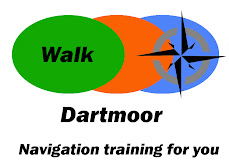Last night will almost certainly be my last group training session at night until the autumn. As the nights get shorter, and days longer, it isnt practical to start your coaching session beyond around 8.30pm. That is unless somebody wants to keep going until 2 in the morning. We all finished at a respectable time last night, the wind was strong but warm, and the visibilty across the moor was generally quite good. The top of North Hessary was cloaked in cloud, which, in Princetown, is only a step away from mist.
Nevertheless, poor visibilty or night navigation was the objective anyway. Off we paced... Now there is an interesting term: 'pace'. Many people ask me how should they define a pace;; every step? every two steps? In most cases people count every other 'step', either the left or right foot. Last night I was asked this and for once I could add something new (Thanks Dr Kate Gilliver, lecturer in ancient history :-) for pointing this out). Pace is derived from the Roman unit of length, which was 5 Roman feet. It is the measure of a full stride from the position of the heel when it is raised from the ground to the point the same heel is set down again at the end of the step. So in short, by definition, it is two steps.
Last night's objective was to enhance already known techniques for the clients. Firstly, how many paces do you do to achieve 100m? The answers varied, and we took mental note of this. OK so now we are going to pace 650m; everyone walked off line astern into the darkness. They then stopped where they believed they should be. I carried on a further 20 paces - 'its here' I said ' please count your paces to join me'. Having done so the group eneterd into discussion while I demonstrated a feature which is most definately 650m from our start point. Now all of these folk are experienced at pacing and have often measured their average pace count on, say, a football field but the darkess and slightly uneven track and created a some uncertainty and shortening of step. By performing the exercise over multiples of 100m (6 or 7 hundred metres) you will also achieve a better average than just counting one leg of 100m.
Everyone made note of their new pacing objective while I set a new target on the map, this time over uneven tussock and off into the moor itself. When walking on a bearing at night try to eliminate as much error as possible; hold the compass level and in front of your body as if you were reading a text message on it, align your body and feet as well as your head to the direction of travel and then start to walk. So many people point their head in the direction of the bearing but their feet take the first few steps on a slightly divergent heading.
Again the group ended up short of their target by a few paces, they then made calculations to assess their 100m pace value for tussocked uneven moorland. Soon everyone was hitting targets, and everyone had a much more comfortable feel for their pacing. The proof of the pudding, as always, is in the eating... The final leg was navigated by a lady who had never walked on the moors at night: 'Its 780m' she said 'That's 7 lots of 100m plus 52 paces for me' she continued; and off they went. 12 minutes or so later.... 'It should be here' she said. Everyone swept their headtorches left and right, and there, not 10 feet away was the boundary stone. Over nearly 800m to an accuracy of 10 feet on a hand held compass - fantastic!





2 comments:
I find white light for night walking & orienteering counterproductive, you pretty much lose your night visibility. Red light is the way to go, especially in winter.
Thanks Hendrik, I have tried red in the past, where I used to keep a small red light for reading the map and a white light for walking. You make a good point though especially with modern LED headtorches, they can really stun you if somebody shines right into your face. Good discipline is needed with any kind of light during a night walk.
Post a Comment